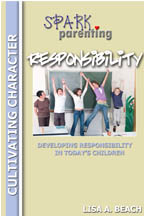 The SPARK Parenting Philosophy The SPARK Parenting Philosophy
 Values: Cultivating Character Values: Cultivating Character
 Life Skills: Preparing Kids to Succeed Life Skills: Preparing Kids to Succeed
 Memories: Weaving Joy Into the Family Culture Memories: Weaving Joy Into the Family Culture

Pre-publication sale! Save 40% by pre-ordering your copy today! |
|
by Lisa Beach
|
 |
As I step over my son’s latest Lego construction, I notice a few books lying on the couch, several Hot Wheels cars wedged under the bookcase (where, apparently, the books never seem to make it back to), a mouth guard (which I’m sure will taste really good with the carpet fibers stuck to it) tossed on the steps and a “special” rock sitting front and center on my son’s placemat. I reach for a Valentine-themed pencil (because we apparently now own pencils for every holiday) to write something on my to-do list, and I see that someone forgot to cap the blue marker (was it the scented marker or the washable one, the fine-tipped or the broad tipped…not sure, we have so many). I pick up the plastic sword stuffed between two couch cushions and return it to its rightful place – next to the dozen or so light sabers, swords, and Nerf guns in our playroom arsenal. And, now that I think about it, what’s up with having a playroom? Why the need for a separate room to store our kids toys, games and art supplies? Why doesn’t it all fit in their bedrooms? How did we accumulate so much stuff and when did it get so out of control?
Cub Scout meeting. Spirit Night fundraiser at local restaurant. Soccer practice. Art class. Church youth group. Popcorn fundraiser. Book club. PTA volunteer duty. Dentist appointment. Canned food drive. Family cookout. Homework. Picture day at school. Birthday party. HOA meeting. Field trip. Chores. Sunday school. Piano lessons. Vacation Bible school. Errands. Playdate. Summer camp. Work deadline. Math club. Class party. Art contest. Sleepover. House project. Pilates class. Parent-teacher conference. Trumpet practice. Football registration. Campout.
My head is spinning. Way too busy.
My 9-year-old keeps bugging me for a cell phone. The fact that he doesn’t even use our home phone to call anyone doesn’t faze him. Everyone has a cell phone, so in his mind, he needs one. Everyone is also signing up for both soccer and football, even though the seasons overlap, meaning double practices and games for a few weeks. Everyone watches Family Guy, so why don’t we? Everyone drinks soda every day, so why don’t we? Everyone plays videogames on school days, owns a PSP, plays M-rated games and watches PG-13 movies. My sons wonder what’s wrong with our family. Why do they get stuck with a mom who sends fresh fruit in their lunch box instead of a bag of potato chips?
Some days, life seems so complicated that I just want to chuck it all out the window and move to an uninhabited island to start over. But reality sets in, and I realize that I couldn’t live without my daily dose of hazelnut coffee from Panera Bread. Nevertheless…
My husband and I finally realized we needed to simplify our family life before our life overtook us. Simplifying and slowing down go hand in hand. By simplifying, I mean making things less complicated, doing more with less, enjoying life’s simple pleasures. By slowing down, I mean creating some breathing room in schedules, saying no to things that don’t really matter, enjoying “right now” instead of “what’s next?”. When we simplify, we often slow down, and vice versa. (Read my article, “15 Ways to Slow Down,” for more insights.)
If you want to simplify your way-too-complicated life, use the following tips as a catalyst for decluttering your own family’s schedule and space:
- Review your current commitments to see if there’s anything you dread. Sometimes we say yes to things out of guilt, peer pressure, habit or obligation. But if an activity detracts from your life rather than adds to it, why keep it on your schedule? If serving on your homeowners’ association board stresses you out, don’t make that commitment. If weekly volunteering with PTA is consuming your life, cut back or eliminate it. Remember, you control what makes it onto your schedule, so only say yes to things you truly want to do. The same holds true for your kids’ schedules. If they used to love Scouts or gymnastics, but now they always seem to make excuses not to go to the meetings or practices, it’s time to reassess these activities.
- Ask, “Do we really need it?” before you buy anything. For example, you might need new kitchen towels, but you don’t need a new pastel-colored set for Easter, a red-white-and-blue set for the 4th of July, a black-and-orange set for Halloween, etc. You can also take this lesson right down to your kids’ level. Somehow, we fell into the innocent habit of buying Hot Wheels cars for our sons as treats when they were younger. After all, the car only cost a buck, right? But over the course of a dozen years, we’ve amassed hundreds of these little vehicles. And now, my little car aficionado requests specific vehicles to add to his overflowing collection. (“I really need the Lamborghini.” Funny how my husband says the same thing.) Anyway, to tame the “more-more-more-mentality” we created, we first made our son pare down his collection by donating the cars he no longer played with. Surprisingly, he parted with dozens of cars. Next, we told our son that we will no longer buy him any cars, unless it’s for a birthday or Christmas gift. So, if he really wanted a specific car, he can use his allowance money to buy it or put it on his birthday or Christmas wish list. This helps him decide whether or not he really needs it in his collection. (This also works well for designer clothes, sneakers, etc. When our kids truly need a new pair of sneakers, we’ll buy a pair we can afford, usually something on sale. If our kids want an over-priced brand just to look cool, they can buy it with their own money.)
- Involve your kids in the daily things you do. Kids need to learn a lot of things before they head out on their own, from cooking meals, doing laundry, and repairing broken things around the house to making a budget, comparison shopping and making healthy choices about food, sleep and exercise. Kids will learn so much more when they work with you side by side and accompany you on errands, especially if you take the time to explain what you’re doing and why it’s important. This helps your kids grow more capable and enables them to truly contribute to the family. Remember, the more kids practice these life skills, the better they get at it. Plus, doing things together simplifies your schedule because you’re all in the same place engaging in the same activity.
- Walk through your home like a first-time visitor. Really take notice of your surroundings, from your furniture, pillows and curtains to your picture frames, candles and knick-knacks. When you purposely look with fresh eyes, you’ll notice that you’ve probably kept many things out of habit. Maybe you received some serving dishes as a wedding gift. You never really liked (or used) them, but they were from your favorite Aunt Mabel, so you hung onto them for the last decade. I heard a great organizing tip somewhere that serves as a litmus test when deciding what to toss and what to keep. If it’s something you still use, something you love or something that adds beauty to your life, keep it. If not, donate it, sell it or toss it.
- Make simplifying easy. Set up a donations box somewhere in your home (perhaps in a closet, laundry room or garage), and regularly purge things you no longer use. Whether it’s part of your weekly cleaning routine or a monthly task, make it a family affair by including both kids and adults in the process. Look in closets, drawers, cabinets, under beds, and on bookshelves to cull unused books, clothes, toys, dishes, linens, household items, etc. Don’t forget to pare down outside areas, such as porches, sheds, garage, etc. (We’re pretty good at decluttering – except for our garage. But that’s next on our project to-do list!) Instruct your kids to put outgrown clothes and unwanted toys and books in the donations box. By designating a specific place to put the give-away items, everyone will know what to do with their unwanted things instead of stuffing them in the back of their closets. Next, create a plan for what to do with the unwanted items. Do you want to sell your things to earn some extra cash? Then list them on Ebay, take them to a consignment store or hold a garage sale. Do you want to give things to friends, neighbors and relatives? Then make deliveries or throw a decluttering party and let guests choose items from your donations box to take as party favors. Do you want to help out a local non-profit and get a tax write-off? Then assemble a list of charities (library, homeless shelter, preschool, teen pregnancy center, etc.) that will accept your donations.
- Stop (or at least control) the inflow of stuff into your home. Practically everywhere we go these days, our kids receive toys, treats and candy. We get lollipops from the bank, candy and toys from the classroom “treasure box,” dollar-store treats from Grandma, stickers at the doctor’s office, kids’ meal toys from fast food places and birthday party favors galore. Other than gently asking Grandma to keep the dollar store goodies at her house, we can’t seem to stop the constant influx of kids’ stuff into our home. (Believe me, I don’t want to be known as The Mean Mom Who Refuses Birthday Party Treat Bags.) So, in addition to regularly purging things from our home, we adopted the “one-comes-in-one-goes-out” rule. For every new item our kids bring home, they need to get rid of something they no longer want. So, a new comic book comes in, an old one gets donated. A new Happy Meal toy comes home, an old one goes to a class treasure box at school. It doesn’t solve the clutter problem, but it does help keep it under control.
- Enjoy the simple pleasures in life. Instead of always looking to enrichment activities, lessons, camps, classes and clubs – not to mention all the electronic gadgets – for family or kids-only entertainment, spend time enjoying simple-but-satisfying activities. For example, instead of going to see a movie based on a book, read the book together as a family. Spend time playing board games and card games. Go for a bike ride. Bake cookies. Put jigsaw puzzles together. Go for a walk in your neighborhood. Take a hike in the woods. Draw or paint a picture. Go swimming or boating at the lake. Listen to music. If you’ve got the voice and the energy, sing and dance, too. Shoot some hoops, toss a football, kick a soccer ball or throw a Frisbee. Enjoy quality time together by simply staying home more often, doing something active and spending more time in nature.
Don’t let your overcomplicated life get the best of you. Simplify your time and space to enjoy a more satisfying, slower-paced journey with your family. 
©2010 SPARKparenting.com All rights reserved.
 |



